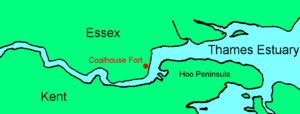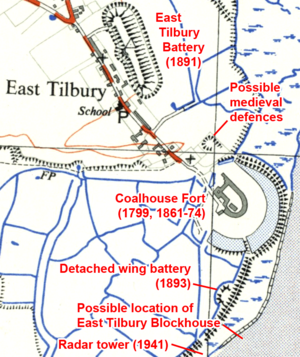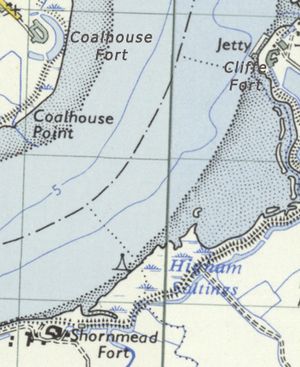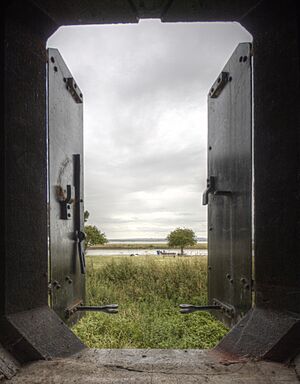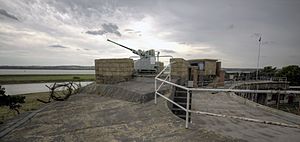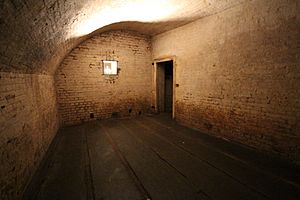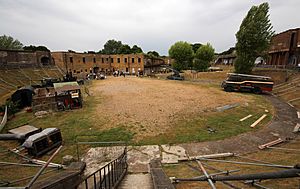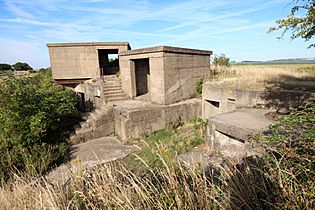Coalhouse Fort facts for kids
Quick facts for kids Coalhouse Fort |
|
|---|---|
| East Tilbury, Essex, England | |
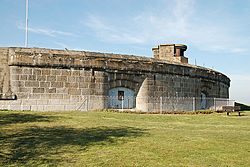
Exterior of Coalhouse Fort
|
|
| Coordinates | 51°27′54″N 00°25′58″E / 51.46500°N 0.43278°E |
| Type | Fortification |
| Site information | |
| Owner | Thurrock Council |
| Controlled by | Coalhouse Fort Project |
| Condition | Intact |
| Site history | |
| Built | 1861–74 |
| Built by | United Kingdom |
| In use | 1874–1949 |
| Materials | Concrete, granite, cast iron, brick, Kentish ragstone |
Coalhouse Fort is an old military fort in Essex, England. It was built in the 1860s to protect the lower part of the River Thames from attacks by ships. The fort stands at Coalhouse Point, near East Tilbury, a place that was often in danger from invaders.
This fort was the last in a long line of defenses built here since the 1400s. It replaced an earlier, smaller fort on the same spot. Building the fort was tough because the ground was marshy, which caused many delays. Even though it had powerful guns and strong defenses, new weapons were invented so quickly that the fort was almost out of date soon after it was finished.
Over 70 years, the fort's guns were changed many times as its role in defending the river changed. At first, it was a main defense, working with Shornemead Fort and Cliffe Fort across the river. Later, as new forts were built further down the Thames, Coalhouse Fort's biggest guns were removed. It was then used for smaller, faster guns to fight against quick ships and planes. Its last military job was as a training place for a few years after World War II.
The fort stopped being used by the military in 1949. It was then used to store shoes for a factory before the local council bought it. The land around it became a public park, but the fort itself slowly fell apart. Since 1985, a group of volunteers called the Coalhouse Fort Project worked to fix it up and use it for history lessons. Money for its repair came from the Heritage Lottery Fund and even from the film studio Warner Bros., which used the fort in the movie Batman Begins in 2005. The volunteer group finished its work in 2020.
History of the Fort
Early Defenses at East Tilbury
East Tilbury was an important place to defend because it was easy for attackers to reach by sea. This area was protected long before Coalhouse Fort was built. For example, French raiders attacked settlements along the Thames in 1379 during the Hundred Years' War. This led to the building of Cooling Castle on the Kent side of the river.
Local people asked for help, and in 1402, the King agreed to build earth walls and towers to protect East Tilbury. We don't know exactly where these early defenses were, but they might have been near St Catherine's Church.
Henry VIII's Blockhouse
Henry VIII ordered a special artillery building, called a blockhouse, at East Tilbury in 1539–40. This was part of a big plan to protect England's coast. He did this because he had separated from the Pope, and he worried that other European countries might try to invade. Five blockhouses were built along the Thames, with two on the north bank at Tilbury and East Tilbury.
The East Tilbury Blockhouse was made partly from stone taken from a nearby chapel. We don't know its exact shape, but it likely had brick and stone walls with a ditch. In 1540, it had fifteen cannons, which increased to 27 by 1539–40. A small group of soldiers and gunners lived there. The blockhouse was disarmed in 1553 and seems to have been abandoned by the end of the 1500s. By 1735, the river had flooded it, and it was in ruins.
The First Coalhouse Battery
In 1687, the Dutch navy attacked the Medway River, showing how weak the Thames defenses were. It took a long time for improvements to be made. During the French Revolutionary Wars, new defenses were finally planned. In 1794, an engineer suggested building three artillery batteries to guard the entrance to the Thames. One of these would be at East Tilbury.
This new battery was built in 1799 on marshy ground near Coalhouse Point. It was named after a coal wharf that used to be there. The soft ground caused many problems, but the work was finished. It had four powerful 24-pounder cannons that could turn easily to track targets. The battery had an earth wall facing the river, and behind it were barracks, a place to store ammunition, and a kiln for heating cannonballs. A water-filled ditch surrounded the whole structure. The battery was abandoned in 1815 after Napoleon's defeat.
The First Coalhouse Fort
Tension between Britain and France grew again in the 1840s. This led to some coastal defenses being updated. The batteries at Shornemead and Coalhouse Point were rebuilt and improved. The Coalhouse battery was greatly expanded between 1847 and 1855 to become a fort. The work was slow because the marshy ground made the foundations crack.
The new fort was built next to the old battery. It had more guns, a total of seventeen 32-pounders. It also had special firing positions to defend against attackers on land. A wide, water-filled ditch surrounded the fort. A bridge on the land side was the only way to get in.
The Second Coalhouse Fort
By the late 1850s, Britain and France were in an "arms race," building more powerful weapons. New, accurate guns and fast, armored warships like the French La Gloire were developed. These ships were a big threat to important naval places on the Thames. Old brick forts could not stand up to these new guns.
In response, a special group called the Royal Commission suggested building a triangle of new forts on the lower Thames in 1860. This meant replacing the old Coalhouse Fort with a new, stronger one. It also involved updating Shornemead Fort and building a new Cliffe Fort across the river. These forts would have guns that could fire at the same area, supporting each other. In wartime, a barrier and a minefield would also be placed near Coalhouse Point.
The new fort was designed with strong granite walls and iron shields, which were thought to be unbreakable. It was planned to have two levels of guns, but this was changed to just one level of gun positions. Like the earlier forts, building it was hard because of the bad ground. Colonel Charles George Gordon, a famous soldier, helped oversee the final stages. The fort cost a lot of money to build.
How the Fort Was Used
19th Century Operations
When Coalhouse Fort was finished in 1874, the guns it was supposed to have were already old-fashioned. Instead, it was given more powerful guns: four 12.5-inch and thirteen 11-inch RML (Rifled Muzzle Loader) guns. These guns could shoot about 5,500 yards (5,029 meters). Three more 9-inch RML guns were placed in an open area. These huge guns were very heavy and difficult to use. They made a lot of noise and smoke, which was dangerous for the gun crews.
The guns were controlled from a special post on the roof. From there, commands were sent to the gun teams using voice pipes. By the late 1890s, three range finders were added to help aim the guns. A skilled crew could fire each gun every two minutes. The guns were set up to fire one after another as an enemy ship passed by. This, combined with fire from Shornemead and Cliffe Forts, would keep constant fire on an enemy from three sides.
New artillery weapons developed quickly, making the fort's original design almost useless within ten years. Its job of defending against large warships was taken over by a new East Tilbury Battery built in 1891. This new battery had more powerful guns that could hide after firing.
At the same time, fast torpedo boats became a new threat. The fort's large guns were useless against them. So, in 1893, a new battery was built nearby with smaller, quick-firing guns to fight these fast boats.
Early 20th Century Changes
By the early 1900s, the fort's main gun positions (casemates) were no longer used because they were too weak against modern artillery. Earth was piled up against the front of the fort, blocking the casemates. Most of the old RML guns were removed. Instead, four 6-inch and four 12-pounder quick-firing guns were placed on concrete platforms on the fort's roof. The larger guns helped the East Tilbury Battery, while the smaller ones defended against fast ships. Two of the old 12.5-inch RML guns stayed until 1912, meant to spray torpedo boats with small metal balls if they got too close.
During World War I, Coalhouse Fort was staffed by soldiers who operated the guns and engineers who ran electric searchlights. A minefield was placed in the river between Coalhouse and Shornemead forts. Friendly ships could pass, but if an enemy ship tried to use the main channel, the mines could be set off from shore. The fort also checked ships entering the river. If a ship was suspicious or refused to stop, the fort was allowed to fire warning shots.
The fort's weapons were reduced during the war as other forts took over some duties. Two 6-inch guns were moved to Cliffe Fort, and the quick-firing guns on the roof were removed. An anti-aircraft battery was set up near the fort to defend against Zeppelins and enemy planes.
1920s to 1940s Operations
After World War I, there were plans to give Coalhouse Fort new 4-inch guns, but these plans were canceled due to budget cuts. The fort was put into "care and maintenance" mode, meaning it was kept but not actively used. East Tilbury Battery was closed in 1930. Forts further downriver took on more responsibility for defending the Thames.
Coalhouse Fort became an "emergency" battery during the early part of World War II. In July 1941, its 6-inch guns were replaced with two 5.5-inch guns taken from HMS Hood. These guns could shoot 12,500 yards (11,430 meters) and were placed in the old 6-inch gun positions. A steel shelter was built on the roof to protect the guns, which were also camouflaged. An observation post on the roof helped find targets, and two remote-controlled searchlights lit up the riverside. These defenses were meant to protect against raids by enemy ships and any landings in the Thames.
The fort's defenses were also improved with two light anti-aircraft guns, including a Bofors 40 mm gun installed on the roof in August 1943. Barbed wire and trenches surrounded the fort. Two special mortars were installed at the back of the fort. A separate concrete tower was built north of the fort to control electrically detonated mines in the river. A radar tower, staffed by navy personnel, was also built south of the fort by 1941 to watch the minefield. An anti-aircraft battery was built nearby and was often used to defend London, sometimes being bombed itself.
By 1944, the threat of invasion had lessened. The fort was then used by the Home Guard. Women from the Wrens also worked at Coalhouse Fort. They operated a special system that checked if ships' steel hulls had been demagnetized enough to avoid German magnetic mines. If a ship was not demagnetized, it was sent back for more work.
The fort became a training base for Sea Cadets and other youth groups after 1946. It was finally closed by the military in 1949.
Fort Architecture
Casemates: Gun Positions
Coalhouse Fort is very well-preserved. It is one of the best examples of a Victorian armored fort. It has twelve casemates, which are strong, arched rooms for guns. They face south and east towards the river. The casemates have thick granite walls and iron gun ports to protect the gunners from flying debris.
Even though the casemates have been changed over time, many original parts remain. The guns are gone, but the metal tracks they moved on are still there. Each casemate had two parts. In times of danger, gun crews would live in the back part. The front part was where the gun was loaded and fired. Iron shields protected each casemate, and thick rope curtains hung from bars to protect the crew from splinters and smoke. A loading bar helped lift heavy shells and cartridges into the gun. Ammunition came up from magazines below using lifts.
Guns in the open battery were lighter and not enclosed. They moved on rails in the open air. A covered path between each gun position led to an ammunition lift shaft.
As gun technology improved, the fort had to change. In the 1880s, huge concrete walls were built between each casemate. This stopped an explosion in one casemate from affecting its neighbors. Concrete pillars were also added inside the casemates to support new guns placed on the fort's roof. The ammunition lifts were extended to reach these new roof guns.
Magazines, Barracks, and Roof
The magazines, where ammunition was stored, were deep under the casemates. They had separate rooms for shells and cartridges. Great care was taken to prevent accidents. Workers wore special clothes and shoes to avoid making sparks. The floors of the cartridge rooms had wooden strips. Oil lamps behind glass windows lit the magazines, keeping the flames away from the gunpowder. Lifts and voice tubes helped workers send ammunition up to the casemates.
A strong brick building, called the barracks, closed off the back of the fort. It had loopholes and windows with armored shutters for defense. The first floor had a balcony facing the fort's inside. The barracks could house six officers and 180 soldiers during wartime. In peacetime, only a small group lived there for maintenance. It also had storerooms and a hospital. While much of the barracks is in poor shape now, two old kitchen stoves and some painted military crests from World War II can still be seen.
The middle of the fort has an irregularly shaped parade ground. A sloping ramp leads up to the casemates. A small brick building, once used as a laboratory, stands near the ramp. The fort is entered through a single gate on its west side, protected by a special defense structure. The front of the fort had a dry ditch, with four defense structures for muskets. A very wide, wet ditch blocked access from the riverside.
The fort's roof was changed a lot in the early 1900s to hold new guns and other buildings. These included positions for 5.5-inch and 6-inch guns, searchlight positions, shelters, an observation post, and a Royal Navy monitoring station.
Outside the Fort
The fort was connected to a jetty, Coalhouse Wharf, on the river. A railway track ran from inside the fort to the jetty. This was used to bring guns and supplies from the wharf. The heaviest guns were moved using special barges called Gog and Magog. Parts of the jetty and railway track can still be seen today.
A two-story concrete building just north of the fort was used during World War II. It was an Extended Defence Officer's Post, controlling the minefield outside the fort. It could also act as a small fort itself. A similar post was on the Kent side of the river. A small concrete building nearby might have been an electrical power house.
A hexagonal radar tower, about 1,300 feet (400 meters) south of the fort, watched over the minefield. It had a concrete structure on a metal frame for the radar, built on top of a brick building. This building held the power plant, electrical equipment, radar screen, and living quarters. It was only used for a short time and is now considered unsafe. Nearby is a separate battery built in 1893, which held four 6-pounder quick-firing guns. Its gun positions and ammunition stores are still mostly intact.
Current Status
After the military left, Coalhouse Fort was rented out and used to store shoes for the Bata shoe factory. It was also used for a while to house soldiers and their families after the war. In 1959, the parade ground was even used to store coal during a miners' strike.
Thurrock Council bought the fort in 1962 and still owns it. The council turned the area around the fort into a riverside park. However, the fort building itself suffered from neglect and vandalism.
Coalhouse Fort and the nearby defenses were recognized as an important historical site in 1962. This was because they are a "remarkable group of defensive sites."
From 1985 to 2020, a volunteer group called the Coalhouse Fort Project leased the fort. They worked to slowly restore it and held regular open days. They displayed military equipment inside the fort, and some casemates had historical displays. The fort was even featured in the BBC TV show Restoration and in the 2005 film Batman Begins, where it was used as a prison. The film's director, Christopher Nolan, saw the fort on TV and decided to use it.
Because parts of the fort were in poor condition, it was added to the Heritage at Risk Register in 2008. English Heritage gave an emergency grant in 2009, along with money from Thurrock Council and the filming fee from Warner Bros. This helped pay for £200,000 worth of repairs to the gatehouse, which were finished in 2011. Grants from other groups have helped build a new block outside the fort entrance for a cafe, toilets, and an information center.
A four-mile (6.4 km) riverside path called the Two Forts Way connects Coalhouse Fort with Tilbury Fort. It is a challenging route for walkers and experienced cyclists. In early 2017, a survey of the site was completed, and repairs to make the fort watertight were expected to begin later that year.
In January 2020, the Coalhouse Fort Project ended its work. This was because they had successfully saved and restored the fort. Thurrock Council and the Heritage Lottery Fund are now responsible for the site's future.



